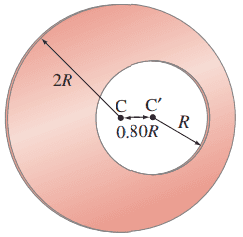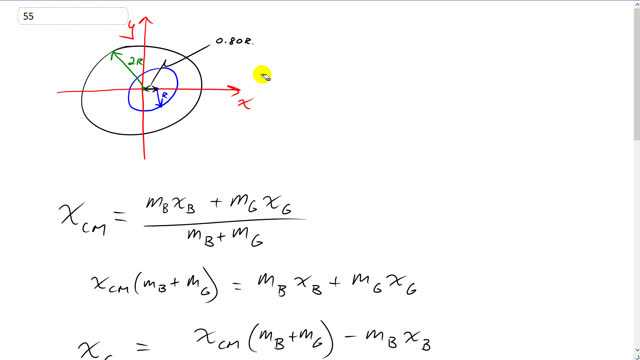
A uniform circular plate of radius has a circular hole of radius cut out of it. The center of the smaller circle is a distance from the center of the larger circle, Fig. 7–41. What is the position of the center of mass of the plate? [Hint: Try subtraction.]


In order to watch this solution you need to have a subscription.
This is Giancoli Answers with Mr. Dychko. So we have a large plate of radius 2R with a small hole cut out of it with radius r and the center of this hole that's cut out is located 0.80R to the right of the center of the big plate. Now we are gonna answer this by considering what if this plate did not have a hole cut out of it; what if it was just one big uniform circle with no holes at all? In that case, the center of mass would be at the geometric center and its position would be 0, 0 when we have our coordinate system set up so that the origin is at the center of the big plate. And so we can write down that the x-coordinate of the center of mass of this big plate with no hole cut out of it... we can think of this big plate with no hole as consisting of two parts hypothetically; we can consider it to be consisting of a part that's in blue like this so again I'm considering this to be not a hole right now and then this big plate also has a green part here. And if you took this green part and multiplied its mass by the distance from the center of mass of the green part to the origin and add to the mass of the blue part times the distance of its center of mass to the origin then divide by the total mass, we would get this answer for the center of mass of the whole entire plate which would be the geometric center of this plate. Now the reason that thinking about it this way is useful because when we set it up this way, we know everything except for this, the center of mass of the green component and that is the question; what is the center of mass of just the green component without considering if this blue part was missing, which is the case, what would the center of mass of the green part be? Hopefully that makes sense. Another way to think about this question is to consider the mass of this hole to be negative and things would work out nicely that way too but I'd like to think of it as this way where you get the whole plate with no hole cut in it and then think of it as consisting of two pieces of positive mass and write down this equation for the center of mass in the x-direction and now that it's done that way, we have this variable x G— x-coordinate of the center of mass of the green portion—in this equation. So this whole thing equals zero because the center of mass of the combined green part and blue part is zero but I haven't written that in yet so let's multiply both sides by m B plus m G and you get this line here and then we solve for x G by moving this term to the left side, that makes it negative m B over m B times x G— I didn't say that right—negative m B times x B and then divide both sides by m G and yeah so this thing is zero so let's get rid of that now and so we have negative m Bx B divided by m G. So the mass of the blue portion is gonna be the area of that blue circle times its thickness t—which we don't know but it doesn't matter, it turns out it's gonna cancel anyway— multiplied by the density of that material and times that by the position of the center of mass of the blue part which is 0.80R to the right of the origin and then divide by the mass of the green part which is the mass of the entire disc with no hole so that's density times π times the radius 2R squared times thickness minus ρπR squared t and the ρ, π and t all cancel everywhere— it's a common factor on top and bottom— and then we are left with negative 0.80R cubed—R squared here times this R— divided by 4R squared minus R squared and that gives 0.80R over 3 negative and so the x-coordinate of the center of mass of the green portion is negative 0.27R. Well, I guess there's not much to show in the calculator there but anyway. So that's 0.27R to the left of the origin and the y-coordinate of the center of mass is gonna be 0 because when you slice it with x-axis, you have an equal amount of mass on the top and bottom and it's equally and totally symmetrical and so the center of mass is gonna be in the middle in the y-direction.